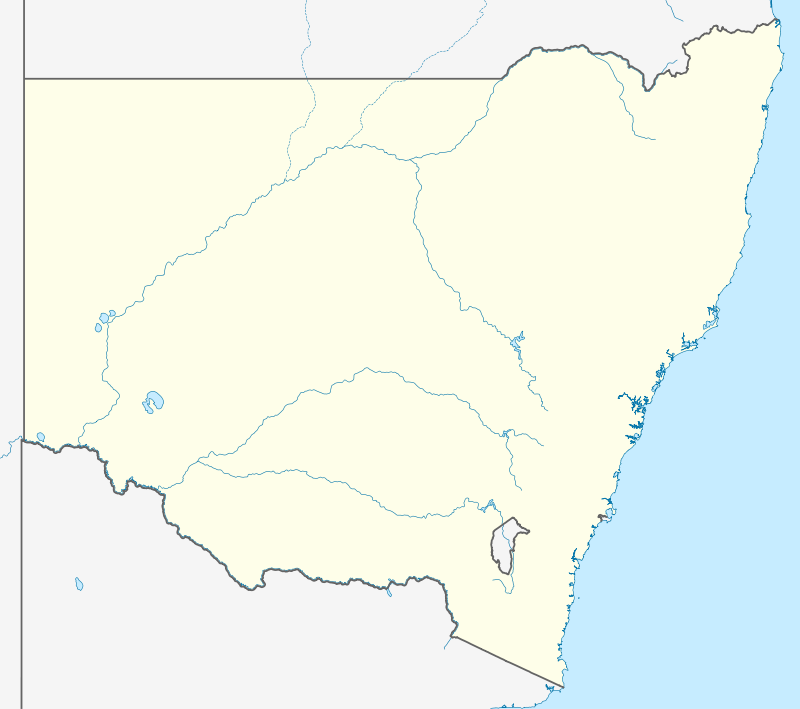Tumbulgum
Tumbulgum (/tʌmˈbʌlɡəm/ tum-BUL-gəm)[2] is a town in northern New South Wales, Australia. The town is in the Tweed Shire local government area, at the confluence of the Rous and Tweed Rivers, 818 kilometres (508 mi) north east of the state capital, Sydney and 120 kilometres (75 mi) south east of Brisbane. At the 2006 census, Tumbulgum had a population of 349.[1]
| Tumbulgum New South Wales | |
|---|---|
 Tumbulgum | |
| Coordinates | 28°17′0″S 153°29′0″E |
| Population | 349 (2006 census)[1] |
| Postcode(s) | 2490 |
| Location |
|
| LGA(s) | Tweed Shire |
| State electorate(s) | Tweed |
| Federal Division(s) | Richmond |
History
In the 1880s Tumbulgum was the principal town in the Tweed Valley with an active commercial sector, including a bank.[2][3] It was not until construction of the rail line to Lismore in 1897 and the Murwillumbah Bridge in 1901 that Murwillumbah supplanted Tumbulgum as the major centre on the Tweed.[3] The Australian Red Cedar growing in the Tumbulgum area attracted timber-cutters from the 1840s and by the early 1860s a small community and river port had been established on the northern side of the Tweed River where it met the Rous.[2] The town was originally called "Tweed Junction" but in 1880 the residents petitioned to have the name changed to "Tumbulgum". This was claimed to mean "meeting place of the waters" in an Aboriginal language but others claimed translations include "a large fig" or "wild fig tree".[2] By 1885, the town had mostly moved to the southern bank of the Tweed.[2]
There is general acceptance among our Tweed Aboriginal community of the presence of three main groups in the Tweed River Valley. These were the Goodjinburra people for the Tweed Coastal area, the Tul-gi-gin people for the North Arm (Rous), and the Moorang-Moobar people for the Southern and Central Arms around Wollumbin (Mt Warning).[4]
Tumbulgum History
- 31 October 1823, John Oxley discovers the Tweed River.
- 1842 Cedar Getters arrive on the Tweed River.
- 1866 the first land selectors arrived on the Tweed River and river port of Tweed Junction established.
- 1 March 1881, name changed from Tweed Junction to Tumbulgum
- 26 January 1883, Baker's Farm Auction enabled development of current village site
- 24 December 1894, Murwillumbah Railway line opened. Murwillumbah replaces Tumbulgum as the commercial centre of the Tweed.
- July 1936, Barney's Point Bridge, Chinderah opens to traffic from Murwillumbah to Tweed Heads. Bypassing Tumbulgum Road and North Tumbulgum.
- 1973, Pacific Highway bypasses Tumbulgum enabling the development of Riverside Drive.
- 20 December 1986, Alexander Twohill Bridge opens replacing the Tumbulgum Ferry.
- 4 August 2002, Yelgun-Chinderah Freeway opens, the old highway route renamed Tweed Valley Way.
The Tumbulgum Heritage Trail was established in 2013. Permanent signs depicting life in Tumbulgum's past, have been installed at 12 sites identified of historical significance. The Trail is a flat walk and takes approx 40–50 minutes. Map of the Trail is displayed in the window of the Community Hall.
Today
Tumbulgum is now an historic village with many buildings in the town—some constructed from the local Red Cedar—having National Heritage classification, including the Tumbulgum Hotel.[2][3] As well as the hotel, facilities in the town include a General Store, newsagency, post office, cafes, restaurants and an antiques store.[5] The town is a popular fishing and boating destination.[6]
Within Tumbulgum and North Tumbulgum are environmental treasures: Stotts Island Nature Reserve, containing a 77 hectare (190 acres) example of lowland sub-tropical rainforest, Duroby Nature Reserve and Skinners Reserve. Tumbulgum itself is both an historic and contemporary hidden gem, tucked away off the busy Tweed Valley Way.[7]
In 2010, Tumbulgum became the third town in New South Wales to ban retail outlets providing disposable plastic shopping bags to customers.[6]
To commemorate 150 years of European settlement at Tumbulgum, a rock monument was placed at Bluey Hill Park in 2016.
Demographics
In the 2011 census, Tumbulgum recorded a population of 383 people, 50.4% female and 49.6% male.
The median age of the Tumbulgum population was 42 years, 5 years above the national median of 37.
78.1% of people living in Tumbulgum were born in Australia. The other top responses for country of birth were England 5.7%, New Zealand 2.1%, Wales 1.3%, Philippines 1%, Denmark 1%.
87.7% of people spoke only English at home; the next most common languages were 1.6% Dutch, 1% German, 1% Italian, 0.8% Greek.
References
- Australian Bureau of Statistics (25 October 2007). "Tumbulgum (L) (Urban Centre/Locality)". 2006 Census QuickStats. Retrieved 11 November 2010.
- "Tumbulgum". Wollumbin Visitor Directory. Big VolcanoTourism Marketing & Media. Retrieved 11 November 2010.
- "Tumbulgum". Tropical NSW. TropicalNSW. Retrieved 11 November 2010.
- https://tumbulgum.wordpress.com/our-past-present-and-future/
- "Tumbulgum". Tweed Tourism Inc. Retrieved 11 November 2010.
- Caton, Peter (27 October 2010). "Tumbulgum ban plastic bags". Tweed Daily news. Retrieved 11 November 2010.
- https://tumbulgum.wordpress.com/about-us/about-2/